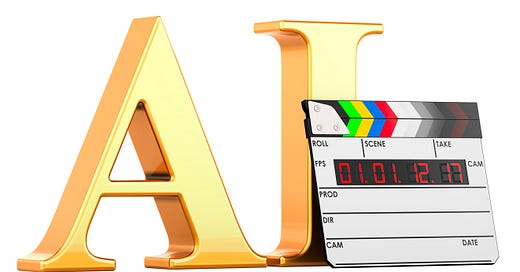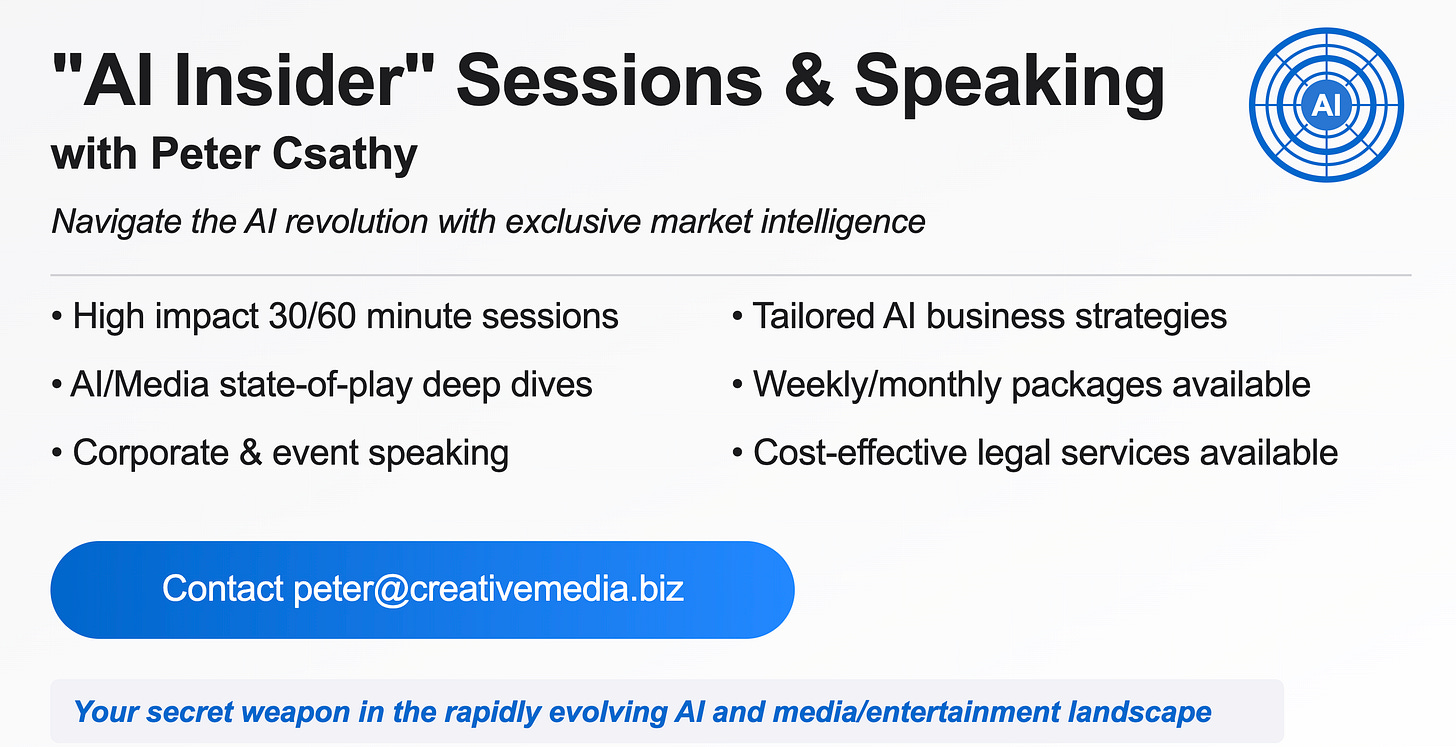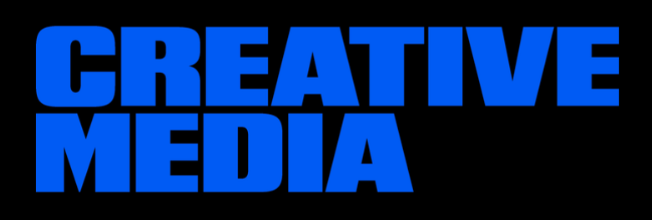A New Narrative For "AI" In EntertAInment
Plus AI Developers Look To Score Their First "Fair Use" Win In Federal Court
Good morning readers, it’s time for your first summer “brAIn” dump! First, the “mAIn event” — featuring a guest article by Tim Carter, CEO of new AI/media company Karmanline. He’s a former long-time Googler and voice worth hearing. Then, the “mosAIc” — a collage of curated “must attend” AI events. Finally, the “AI Litigation Tracker” — updates on key generative AI copyright infringement cases by Partner Avery Williams of McKool Smith (access the “Tracker” here via this link).
But First …
(1) “Fair Use” Watch!
I always try to “keep it real.” On that note, late last week, federal Judge William Alsup, in an important summary judgment hearing in AI infringement case Bartz v. Anthropic, made statements that didn’t bode well for copyright owners on the pivotal issue of "fair use” (in contrast to Judge Vince Chhabria’s opposite leanings in another federal court in California, about which I recently wrote).
Judge Alsup said this about accepting Anthropic’s “fair use” defense to unlicensed training on copyrighted works: "That's kind of the way I'm leaning right now." But then Alsup immediately also said this: "Sometimes I say that and change my mind." He also expressed angst at Anthropic's use of pirated books. "I have a hard time seeing that you can commit what is ordinarily a crime, but get exonerated because you end up using it for a transformative use" he said. So, there's that.
To be clear, it’s not unusual for federal district courts to split on novel issues they face. But appeals follow, of course — and ultimately the Supreme Court may face the issue.
Bottom line: I continue to believe that the courts — and ultimately, the Supreme Court — will reject "fair use" as a defense to mass infringement. But it may take years to play out. So what happens until then? After all, GenAI certainly won’t stop.
Speaking of …
(2) Google’s Latest AI Video Generator, Veo 3, Unveiled
Google announced 100 “things” at its annual Google I/O conference last week, the most mind-blowing of which was Veo 3, it’s new video generator. Axios reports that Veo 3 “generates clips that most users online can’t seem to distinguish from those made by human filmmakers and actors.” Unlike OpenAI’s Sora, users of Veo 3 can also automatically generate sound (dialogue, soundtracks and sound effects). Here’s Google’s demo of it all.
What does it mean for filmmakers, advertisers and anyone in video production? It’s certainly sobering. Nonetheless, I continue to believe that there’s something “transcendent” about filmmaking with humans at the helm (as I wrote last week).
I. The mAIn Event - A New Narrative for “AI” in EntertAInment
By Tim Carter, CEO of Karmanline
"AI" is an enigma. Since it is not one single type of technology but rather an ambition, it is deliberately hard to classify.
And yet it is here, in various forms, encroaching on creative, administrative and operational work without yet a clear narrative for how it can be deployed in service of storytelling and the businesses we build around that.
Uncertainty breeds uncertainty. But this is a pivotal time for action.
We need a tangible approach to integrating "AI" into the entertainment industry driven by our own needs to solve real problems and leverage deep skills.
So here are three concrete ways AI can help optimize creativity and production – three ways — ideas to form a practical narrative.
1: Story Creation
We face an undeniable challenge creating new visual stories today, because we operate a flawed story workflow. We build visual projects in text(!) so every collaborator has to interpret their own visual meaning from what’s written — and every contributor spends time correcting that vision instead of elaborating their story. We run scenarios on the surface because committing too deeply is time consuming, costly, and impractical.
Visual story creation process should deliver instant feedback to creators as they build out each element of their story: opening, plot, character, mood.
“AI” can in fact help here, by automating the process of text visualization at any stage of development. Modern “AI” systems fundamentally built on the structure of language are increasingly capable of converting text to relevant images, and running alternative scenarios based on human notes (‘prompts’). Iterations can be fast, maximizing the creative options we can explore at the cheapest stage of production — development. Meanwhile all tools and their inputs and outputs can be tracked, enabling clear IP reporting, licensing and protection.
2: Production Planning
As we collaborate in development and prep, we only see the true implications of our ideas for locations, scenes, shots, budgets, schedules, etc. late in the process. Often too late, when we are on set, with dozens or hundreds of people in tow. Or when we’ve already chosen our locations based on cast, crew, and financing. Prep feels wasted if it doesn’t end up on screen, so we focus on the most complex and costly of scenes, costumes, and props.
Production planning should integrate directly with the story creation process from the outset, so that every location option, shooting schedule, cast choices, and right down to individual shots are automatically defined or optioned based on the story’s iterations.
“AI” automations can be highly effective at stringing together distinct areas of know-how to produce such combined suggestions, giving production teams a head start on the detailed work of bringing creative ideas to life, running alternative scenarios rapidly and in sufficient detail to be decisive.
3: Production Operations
Hundreds of processes must align to deliver the complexity of a film, TV, or commercial, covering creative, practical and administrative tasks and roles. Too often these are separated for most of the life of the production, uniting only fleetingly through manual and often distant connections in production meetings, emails, spreadsheets, contracts and accounts. This produces no unified overview of production, and no opportunity for continuous learning from each production to make the next one its best version of itself.
Production operations should be baked into the production process from the outset.
Chain of title, financing and reporting should be monitored and maintained automatically by all activities undertaken to deliver the production. Creative freedom should be maximized within the clear boundaries of those constraints, and all teams should have access to the core production data, milestones and outputs they need to do their jobs.
AI For Human Benefit, Not Displacement
In these three ways we can see how “AI” automation can make sense, supporting creatives, producers and studios to streamline existing processes and solve real problems. Automated visualisation enhances story development and collaboration, allowing for data-driven planning and real time adjustments. Responsive and transparent tracking and reporting can help build collective knowledge for productions over time.
We need to shift our thinking from "AI" as a concept with endless possibilities, to a mechanism with specific capabilities. With only a little imagination we can harness “AI” automations for what they are good at — and serve the needs of people. In the process we might just secure value and power in the things we create and open new methods for creating the best stories from all voices in every context.
Until then, our reality means:
1. The Internet uncorked media distribution, moving power [audience + revenue] from separate legacy gatekeepers in production [studios] and distribution [theatres, TV, home video] to new integrated gatekeepers (streamers);
2. Mobile accelerated this trend, introducing yet more gatekeepers in distribution (platform app stores) and audience aggregation (social media services), and fragmenting channels, formats, and audiences behind those gatekeepers and simultaneously dis-intermediating creators from audiences while mediating their value; and
3. Costs grew from this new competition, investments were demanded for new business models, and COVID19 accelerated existing trends, making every production more expensive just as revenues dwindled — squeezing margins and giving the gatekeepers of consumer cash and attention (streamers, platform app stores, and social media services) ever greater collective leverage over creators and studios.
“AI” is actually perfect for the entertainment industry, because we are one of the few domains where humans are definitively in control of what is deemed high quality — you cannot outsource taste, or opinion. So the outsourcing of certain work to automation can only exist within that wider edited, directed, and produced world run by human taste-makers.
The creative freedoms automation can unlock are specifically valuable in entertainment, but not unique. Creative thinking is prized in countless other domains, so perhaps the entertainment industry can lead the way in how to adopt “AI” for human benefit, rather than displacement.
ABOUT THIS WEEK’S GUEST AUTHOR: Tim Carter’s 25 year career in business, tech and law includes 10 years as an IP lawyer, and 8 years at Google leading Android’s business outside the US. A serial strategic leader, before co-founding Karmanline he led responsible AI and rights management at Flawless AI. Karmanline is an entertainment technology company building visual planning tools for creators and producers. Formed by a world class team of tech and entertainment industry veterans, Karmanline also consults on AI production.
[PETER’S POST-SCRIPT: I feel it’s important to highlight smart minds that demonstrate the power of AI. But to be clear, I give no endorsement for using AI tools that violate the rights of media, entertainment, and the overall creative community.]
II. The mosAIc — A Collage of Curated “Stuff”
(1) “AI on the Lot” Is This Week! (I’ll Be There … You Should Be Too)
LA’s biggest AI media and entertainment event of the year — AI on the Lot — takes place THIS WEEK starting Wednesday, May 28th and running through the 30th. It’s one of those rare “must attend” conferences and schmooze-fests, and I’ll definitely be there on the 29th. Reach out to me at peter@creativemedia.biz if you’d like to meet up. Tickets are still available — get an extra $100 off by using the discount code “PETER” via this link.
(2) Westside Digital Mix Hosts Great Networking Events
Another great resource for you is Westside Digital Mix. This storied group of media/tech experts (like my friend, Spence Bovee) host an ongoing series of great LA-based media, entertainment, AI and tech networking events. Their newsletter is also a helpful resource for all major media/tech events in the LA area. Check it out here.
Want to Work Together?
Reach out to me at peter@creativemedia.biz.
III. AI Litigation Tracker: Updates on Key Generative AI/Media Cases (by McKool Smith)
Partner Avery Williams and the team at McKool Smith (named “Plaintiff IP Firm of the Year” by The National Law Journal) lay out the facts of — and latest critical developments in — the key GenAI-focused IP litigations below. All those detailed updates can be accessed via this link to the “AI Litigation Tracker”. McKool is a leader in both copyright and patent-related AI litigation — and all IP matters.
(1) Kadrey v. Meta
(2) Ziff-Davis v. OpenAI
(3) The New York Times v. Microsoft & OpenAI
(4) Thomson Reuters v. Ross Intelligence
(5) In re OpenAI Litigation (class action)
(6) Dow Jones, et al. v. Perplexity AI
(7) UMG Recordings v. Suno
(8) UMG Recordings v. Uncharted Labs (d/b/a Udio)
(9) Getty Images v. Stability AI and Midjourney
(10) Universal Music Group, et al. v. Anthropic
(11) Sarah Anderson v. Stability AI
(12) Raw Story Media v. OpenAI
(13) The Center for Investigative Reporting v. OpenAI
(14) Authors Guild et al. v. OpenAI
NOTE: Go to the “AI Litigation Tracker” tab at the top of “the brAIn” website for the full discussions and analyses of these and other key generative AI/media litigations. And reach out to me, Peter Csathy (peter@creativemedia.biz), if you would like to be connected to McKool Smith) to discuss these and other legal and litigation issues. I’ll make the introduction.
About My Firm Creative Media
My firm and I represent media companies and rights-holders for generative AI content strategy and licensing, with deep relationships and market insights and intelligence second to none. We know the key players inside AI tech and pride ourselves in reaching THE key decision-makers and influencers in record time to execute. Not just talk. We specialize in breakthrough business development and M&A and cost-effective legal services in the worlds of media, entertainment, AI and tech.
Reach out to me at peter@creativemedia.biz to explore working with us.
Send your feedback to me and my newsletter via peter@creativemedia.biz.











This from Tim's piece is spot on: "You cannot outsource taste, or opinion."
Thanks. I love the insight of traditional movie scripts going out the window because AI will enable script writers to visualize their ideas.
This resonates with the concept that product managers can now "vibecode" working prototypes without relying on engineers.
What happens to the quality of end products when concepting and experimentation get much cheaper?